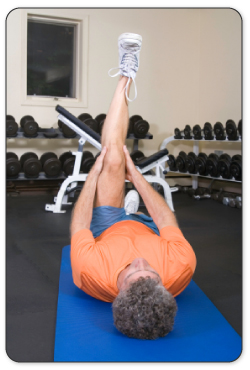|
| Preventing Hamstring StrainsDo Appropriate Exercises and ActivitiesIf you are suffering from hamstring pain, listen to your body and decrease, modify and/or avoid any activities or motions that cause pain and irritation (quick stopping/starting, turning, running or jumping, as well as participating on uneven terrain). If you are required to perform these motions at work or play and cannot avoid them, make sure you take frequent breaks and rest to prevent fatigue and pain. Before beginning exercise or training, ask your doctor or physical therapist for a list of appropriate exercises that will not cause further harm to your weak hamstrings while you work to strengthen them.  To stabilize your hamstring and leg area, and increase your range of motion, maintain and build your strength, stability and flexibility of your hamstring, leg, gluteal, pelvis, low back and core body muscles. Light weights, exercise bands and balls are very beneficial for strengthening your lower body. Procioceptive training (core balance training) and plyometrics (exercises to develop strength, speed and agility, such as jumping or bounding movements) are also an excellent addition to your exercise routine. Yoga, tai chi, or a daily stretching routine will help to keep your muscles and joints supple (avoid sudden twisting and turning motions). A regular exercise program that focuses on total body fitness and includes low-impact aerobic activity at least 3 days per week, such as walking, swimming or biking will help to keep you healthy overall and will strengthen your body to prevent against further hamstring injuries. Avoid Doing too Much to SoonGive your body an opportunity to build up its endurance. This is especially important when participating in a new activity. Gradually increase your participation to prevent overstraining your muscles. Pulled Hamstring TreatmentsHamstring injuries are frustrating to live with and healing can take a long time because it's difficult to give your leg the rest it needs. This is especially true for runners and other athletes that return to their sport too early. Re-injury is common but it prolongs recovery and may also lead to permanent damage and other conditions. Treating your hamstring strain correctly is essential to getting rid of your pain and restoring function to your upper thigh. Proper treatment will get you back to regular activities sooner, stop your pain, and reduce the risk of future re-injury. Learn More About Hamstring StrainHamstring Strain Causes Hamstring Strain Symptoms Hamstring Strain Progression (Grades of Strain) Hamstring Strain Diagnosis Hamstring Strain Home Treatments Hamstring Strain Surgery Hamstring Strain Post-Surgery Recovery Hamstring Strain Prevention Product specialists are available 9:00 am to 5:00 pm Eastern Standard Time Monday to Friday. If any question or concern arises, call us or simply send us an email at any time (we check our emails constantly all throughout the day and night.. even on holidays!). We will respond as soon as possible. North America Toll Free 1-866-237-9608 |
    |


